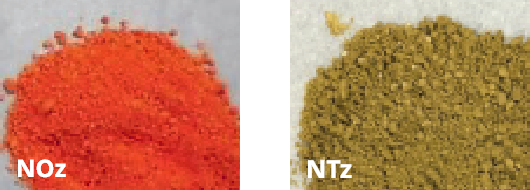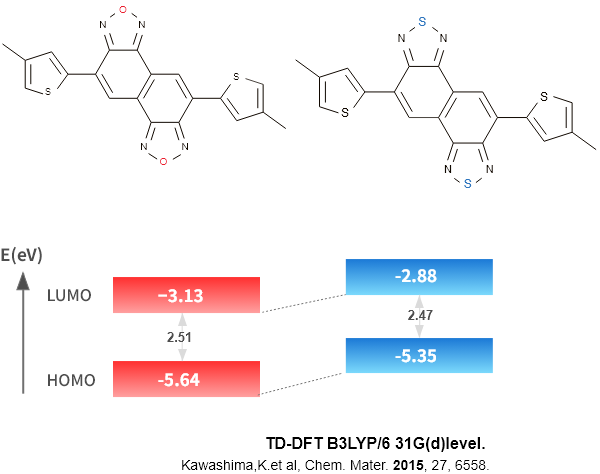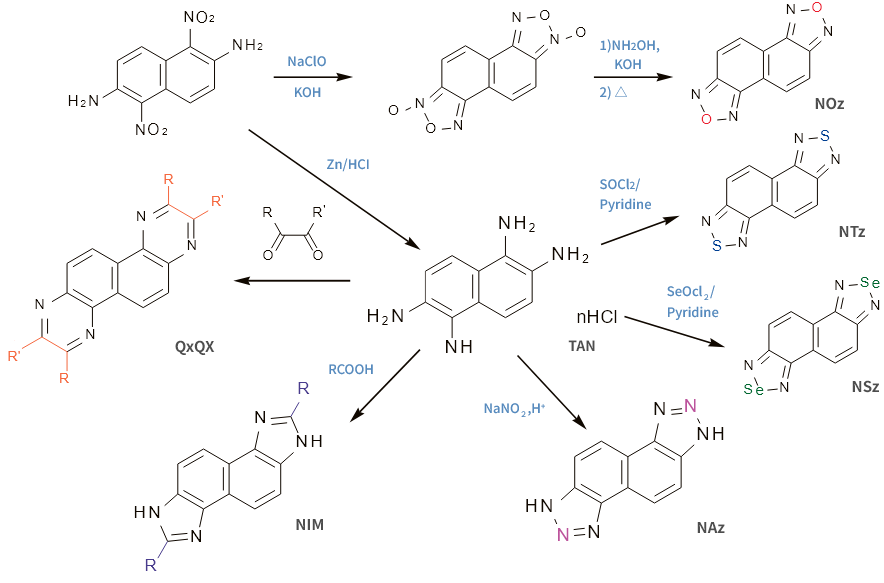Organic semiconductor materials
NTz, NOz


A variety of naphthobisc chalcogenadiazole (NTz, NOz) derivatives with a rigidtetracyclic structure are available, and polymer materials incorporating NTz and NOz have been reported to exhibit excellent semiconductor properties1~2). In addition to NTz and NOz, various nitrogen-containing heterocyclic compounds can be synthesized from 1,2,5,6-tetraaminonaphthalene (TAN), which is a precursor for NTz synthesis. This material has high potential as a building block for constructing optical and electronic devices. This material has high potential as a building block for constructing optical and electronic devices.
- 1) Kawashima, K. et al, J. Am. Chem. Soc. 2016, 138(32), 10265.
- 2) Kawashima, K. et al, Nat. Commun. 2015, 6, 10085.
Features and characteristics
- ・Strong electron acceptability, rigidity
- ・Low HOMO-LUMO energy levels
- ・Narrow HOMO-LUMO band gap
NTz
- CAS NO,
- 133546-47-1
BR2-NTz
- CAS NO,
- 133546-50-6
PB2-NTz
- CAS NO,
- 1467776-41-5
NOz
- CAS NO,
- 1394221-73-8
BR2-NOz
- CAS NO,
- 1437229-13-8
PB2-NOz
- CAS NO,
- 18422-53-2
Relevant building blocks

Pharmaceutical intermediate materials
R-BAMP
- CAS NO,
- 147081-49-0
We can also propose optically active pyrrolidine and piperidine compounds. Sankyo Kasei’s unique manufacturing process achieves high optical purity.
We offer a lineup of both five-membered cyclic amine 3-aminopyrrolidine and six-membered cyclic amine 3-aminopiperidine compounds, which are useful intermediates for pharmaceuticals.
S-BAMP
- CAS NO,
- 147081-44-5
R-MAMP
- CAS NO,
- 457097-75-5
S-MAMP
- CAS NO,
- 214357-95-6
R-3ZAP
- CAS NO,
- 879275-77-1
S-3ZAP
- CAS NO,
- 176970-12-0
R-MAMPI
- CAS NO,
- 1001353-92-9
S-MAMPI
- CAS NO,
- 902152-76-5
R-3BDAPI-PTSA
- CAS NO,
- 1224179-17-2
S-3BDAPI-PTSA
- CAS NO,
- 1224179-19-4
R-3BDAP-PTSA
- CAS NO,
- 1224179-13-8
S-3BDAP-PTSA
- CAS NO,
- 1224179-15-0
D-Epoxone
- CAS NO,
- 18422-53-2
D-Epoxone was developed by Professor Shi at Colorado State University in 1996. It is very effective in the asymmetric epoxidation of transalkenes and is one of the most useful catalysts for the synthesis of pharmaceuticals.
D-Epoxone is synthesized from D-fructose.
However, this known synthetic method has been difficult to industrialize
from the viewpoints of environmental impact, safety, and economy.
We have established an industrial production method without the use of heavy metals to solve these problems.
- Appearance
- White powder
- G C
- Over GC 99.0 area%
- Specific rotation
- -122.0±1.5°
- Melting point
- 102~106℃
Reaction example

Reaction example

Synthesis example

